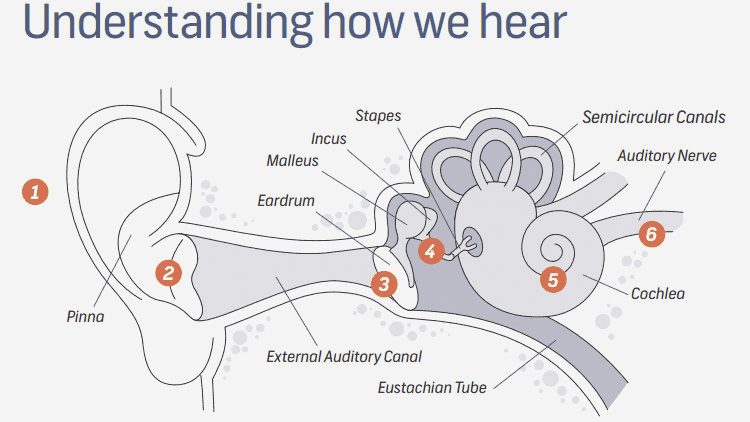Hearing Information

SENSE OF HEARING
Outer Ear
Known as the pinna or auricle, the visible portion of the ear gathers sounds from the surrounding environment and sends it down the ear canal.
Middle Ear
The vibration of the tympanic membrane (eardrum) transmits sound to the inner ear through three small bones (malleus, incus and stapes) that carry sound to the inner ear.
Inner Ear
Made up of two main parts, the cochlea, a system of complex hair cells (sensory cells), and the vestibular system, which in turn sends it to the brain for the final processing of the sound.
HEARING LOSS
Sensorineural Hearing Loss
This type of hearing loss involves the deterioration of the inner ear. The tiny hairs that line the ear passage, and which carry sound, have been damaged. This type of hearing loss is most commonly caused by prolonged exposure to high volume levels, bacterial and viral infections, fluid build-up, sudden trauma to the ear, and the normal aging process. Sensorineural hearing loss cannot be treated with medication or surgery, and hearing aids are the only way to treat this permanent type of hearing loss.
Conductive Hearing Loss
This type of hearing loss occurs when the inner ear does not properly receive signal signs. This type of hearing loss can be caused by injury to the middle ear or ear canal, fluid build-up behind the eardrum, or excessive earwax. Conductive hearing loss can usually be treated medically. If surgery or medication is not an option for you, hearing instruments can be an excellent solution to your hearing problem.
HEARING LOSS SIGNS
Signs of hearing loss may take some years to develop, they may show up very suddenly. It will make everyday life more difficult. If you say yes to several of the sentence below, you may have a hearing loss and to contact us.
- Frequent repetition of words
- Difficulty following conversations
- Others sound muffled
- Difficulty hearing in noisy situations, like conferences
- Trouble hearing children and/or women voices
- TV or radio turned up to a high volume
- Answer or respond inappropriately in conversations
- Ringing in the ears
- Read lips or more intently watch people’s faces when they speak
- Feel stressed from straining to hear what others are saying
- Feel annoyed at other people because you cannot hear or understand them
- Family history of hearing loss
- Medications that can harm the hearing system
- Diabetes, heart, circulation or thyroid problems
- Exposed to very loud sounds over a long period
WORKING CONCEPT OF HEARING AIDS
Hearing aid works with several key configurations that enable you to hear better while wearing the instruments.
Incoming Sound is picked up by the microphone in the hearing aid and processed in the circuit board (hybrid) and changes the sound waves to electrical signals and modifies it based on the computer data provided by the Hearing health provider and the circuit is manipulated by the sophisticated software to do the functions based on the facilities and technical datas of the hearing aid they provide.
In some higher end models following manipulations are possible.
- Detect feedback and virtually eliminate it
- Reduce harsh effects of loud sounds
- Reduce almost all background noise hindering speech perception
- Enhance the fine nuances of music
and the receiver receives the signals and it is converted to sound and deliver through the ear canal.
BATTERY provides the power to the hearing aid. Consumption of the battery depends on the hearing aid provides bythe Hearing health provider.

